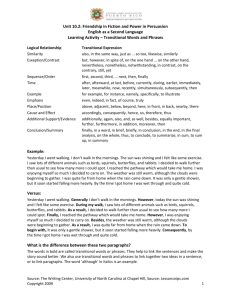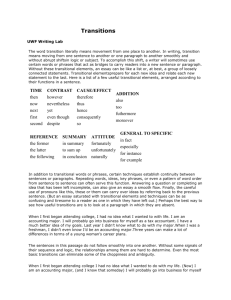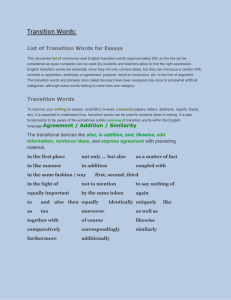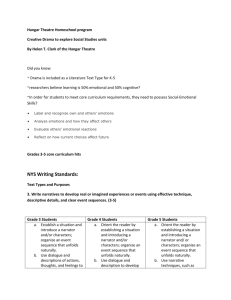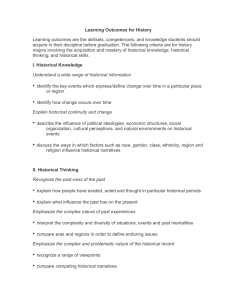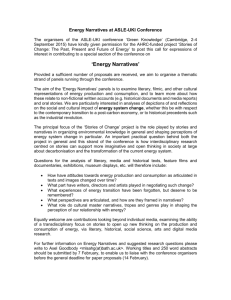2014 Study Guide for Unit 1
advertisement
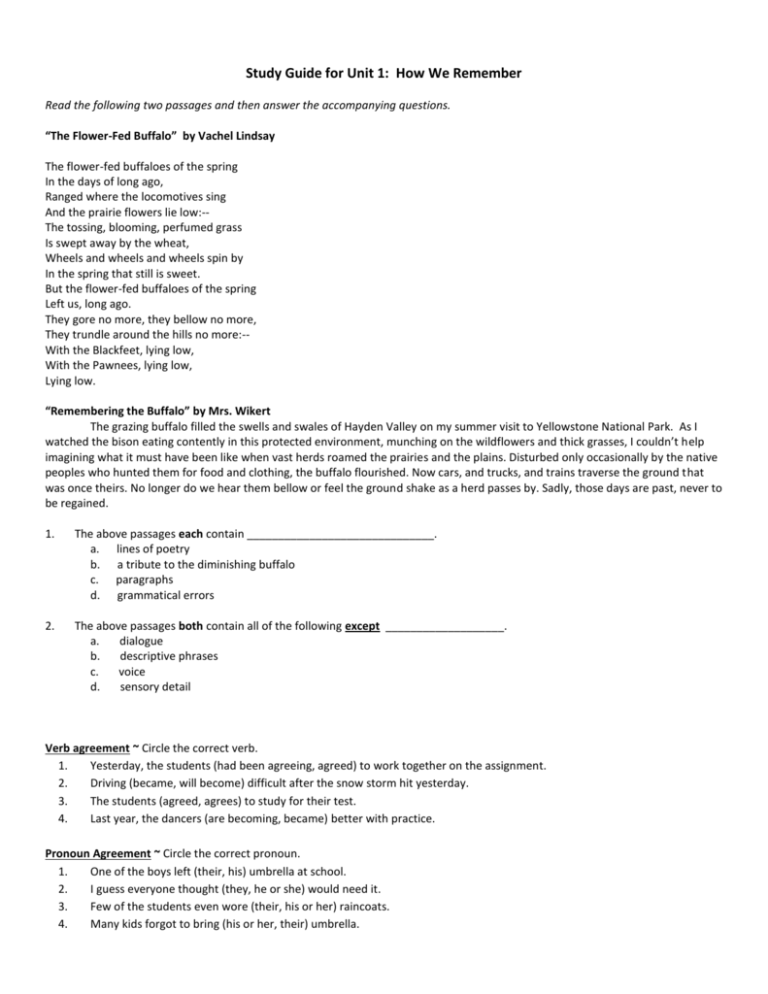
Study Guide for Unit 1: How We Remember Read the following two passages and then answer the accompanying questions. “The Flower-Fed Buffalo” by Vachel Lindsay The flower-fed buffaloes of the spring In the days of long ago, Ranged where the locomotives sing And the prairie flowers lie low:-The tossing, blooming, perfumed grass Is swept away by the wheat, Wheels and wheels and wheels spin by In the spring that still is sweet. But the flower-fed buffaloes of the spring Left us, long ago. They gore no more, they bellow no more, They trundle around the hills no more:-With the Blackfeet, lying low, With the Pawnees, lying low, Lying low. “Remembering the Buffalo” by Mrs. Wikert The grazing buffalo filled the swells and swales of Hayden Valley on my summer visit to Yellowstone National Park. As I watched the bison eating contently in this protected environment, munching on the wildflowers and thick grasses, I couldn’t help imagining what it must have been like when vast herds roamed the prairies and the plains. Disturbed only occasionally by the native peoples who hunted them for food and clothing, the buffalo flourished. Now cars, and trucks, and trains traverse the ground that was once theirs. No longer do we hear them bellow or feel the ground shake as a herd passes by. Sadly, those days are past, never to be regained. 1. The above passages each contain ______________________________. a. lines of poetry b. a tribute to the diminishing buffalo c. paragraphs d. grammatical errors 2. The above passages both contain all of the following except ___________________. a. dialogue b. descriptive phrases c. voice d. sensory detail Verb agreement ~ Circle the correct verb. 1. Yesterday, the students (had been agreeing, agreed) to work together on the assignment. 2. Driving (became, will become) difficult after the snow storm hit yesterday. 3. The students (agreed, agrees) to study for their test. 4. Last year, the dancers (are becoming, became) better with practice. Pronoun Agreement ~ Circle the correct pronoun. 1. One of the boys left (their, his) umbrella at school. 2. I guess everyone thought (they, he or she) would need it. 3. Few of the students even wore (their, his or her) raincoats. 4. Many kids forgot to bring (his or her, their) umbrella. 5. If anyone gets wet, that’s (their, his or her) own fault Use the following excerpt from “The Great Rat Hunt” by Laurence Yep (114) to answer the next two questions: Shortly after that, the rat left as mysteriously as it had come. “I must’ve scared it off,” Father announced. Mother shook her head. “That rat laughed itself to death.” Father disappeared into the storeroom: and for a moment we all thought Mother had gone too far. Then we heard the electric saw that he kept back there. “What are you doing?” Mother called. He came back out with a block of wood about two inches square. He was carefully sandpapering the splinters from the edges. “Maybe someday we’ll find the corpse [of the rat]. Its head ought to look real good over the fireplace.” Mother was trying hard to keep a straight face. “You can’t have a trophy head unless you shoot it.” “If it died of laughter like you said, then I killed it,” he insisted proudly. “Sure as if I pulled the trigger.” He winked at me. “Get the varnish out for our trophy will you?” I was walking away when I realized he had said “our.” I turned and said, “That rat was doomed from the start.” I heard my parents both laughing as I hurried away. 1. What writing technique does the author use to convey humor in this passage? a. step-by-step instructions b. compare/contrast c. letter style d. dialogue 2. Life lesson: When Father said “our trophy” Laurence realized that ______________. a. laughter can kill rats. b. his father liked to make things from wood. c. he and his father had become closer. d. varnish is used on trophies. Transitional phrases (p. 572) a prefix meaning “across” or “through” and used in particular to form verbs denoting movement or conveyance from place to place (transfer; transmit; transplant; transport) Transitional phrases and words help connect your sentences and paragraphs, making it easier for your reader to follow your ideas. Turn to pages 572-573 in our Write Source book and choose three transitional words and/or phrases from each of the following categories: 1. Transitional words that can be used to show time: _________ _____________ _____________ Now, write a sentence using a transition that can be used to show time. Example: After the pep rally, the staff and students were even more excited about homecoming! _________________________________________________________________________________________ 2. Transitional words that can be used to conclude or summarize: __________ __________ _____________ Write a sentence using a transition that concludes or summarizes. Example: Finally, the game was over after double overtime. ________________________________________________________________________________ 3. Transitional words that can be used to add information: __________ ___________ __________ Write a sentence using a transition that can be used to add information. Example: For example, this sentence begins with a transition that can be used to add information. ________________________________________________________________________________ Turn to “Flying” on page 119 in our literature anthology and list at least three transitional words or phrases and give the page number. For example: When I was your age, I was flying. I wasn’t flying all the time, of course, and I didn’t fly by myself, but there I was, nonetheless, on Saturday afternoons . . . (119) ___________________________________________ ( ) ___________________________________________ ( ) ___________________________________________ ( ) Writing Process prewriting 1. 2. 3. 4. 5. writing revising editing publishing In the ______________ stage, the writer checks his/her rough draft for errors in punctuation, capitalization, etc. A writer explores possible topics they could write about in the __________________ stage. In the _____________ stage, the writer prints and shares the final copy of the written product. A writer uses their prewriting ideas to begin writing their rough draft in the _______________ stage of the writing process. The writer makes major changes to ideas that are not clear in this stage __________________. Narratives can be real or imagined, are filled with sensory details, and are organized with a beginning, middle and end. FYI: A memoir is one type of narrative. Even though memoirs are centered around real experiences, what are some things that might be imagined? _____________________________________ _______________________________________ A narrative is writing that tells a story. Circle the three descriptions of a narrative that are false. a. b. c. d. e. f. g. h. Events can be real or imagined. Narratives should have well-structured event sequences. Narratives that deal with real events include memoirs and autobiographies. Fictional narratives include myths, short stories and novels. All narratives must be set in a forest. Narratives include well-chosen sensory details. Narratives must have a happy ending. Narratives require a certain number of characters/people. Devices Used In Writing “How did you learn how to hunt?” I asked. “From your father?” My father rarely spoke to of his father, who had died before I was born. He winced now as if the rat had just nipped him. “My old man? Nah. He never had the time. I learned from some of my buddies in Chinatown.” 1. What writing technique does the author use in the above excerpt to give insight into the thoughts and feelings Laurence Yep’s father had about his relationship with his own father? a. Letter b. Dialect c. Dialogue d. Suspense 2. The following statements are all examples of… a. Transitional Phrases b. Dialect c. Dialogue - Meanwhile back at the ranch, - After a few minutes, - When everything was in place, 3. Which technique helps the reader create an image in his or her mind? a. Transitional phrases b. Suspense c. Descriptive details d. Shows possession Intended audience is the person or people to whom the statement is being made. In other words, who could be hearing these words? For whom is this statement meant? Who is the intended audience of the following statements—possible responses: Someone of similar age, Someone much older, Someone much younger “Please be very careful when crossing the street. Make sure you hold onto an adult’s hand and look both ways!” ________________________________ “Let’s go to the mall and pick out cute outfits for our dance on Friday!” ______________________________ “When you were my age, what kind of chores did you have to do?” ________________________________ “Why can’t I go, too? Everyone else is going! You just don’t understand.” ___________________________ “When I was your age, I had to get up before dawn, milk the cows, and gather the eggs.” _______________ Setting 1. The setting of the story Block Party is summer. Which line of story helps the reader to determine the setting? a. “Street wires crossed overhead” b. “We lived in the dark green hills of Pittsburgh” c. “Lots of women acted like my mother” d. “We had a red tricycle with a bell” Poetry interpretation Read the following stanza from “If” by Rudyard Kipling: If you can keep your head when all about you Are losing theirs and blaming it on you, If you can trust yourself when all men doubt you, But make allowance for their doubting too; If you can wait and not be tired by waiting, Or being lied about, don’t deal in lies, Or being hated, don’t give way to hating, And yet don’t look too good, nor talk too wise: . . . Yours is the Earth and everything that’s in it, And—which is more—you’ll be a Man, my son! What is the best interpretation of this stanza? a) Don’t blame others for your problems b) Keep calm and have faith in yourself when facing adversity c) What goes around comes around d) Limitations are necessary to succeed To whom is the speaker talking? In other words, who is the intended audience? _______________

